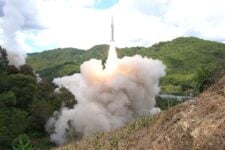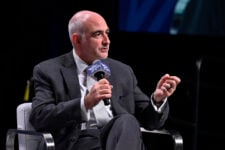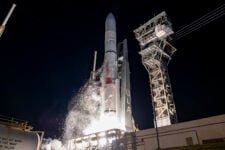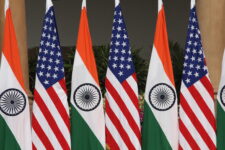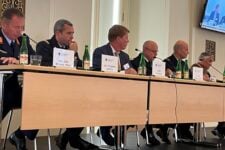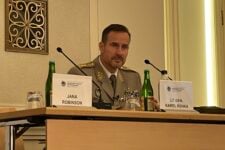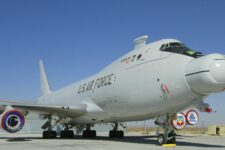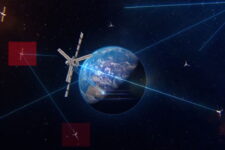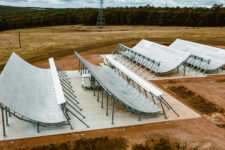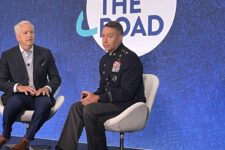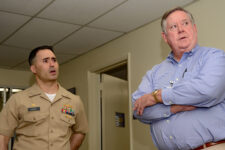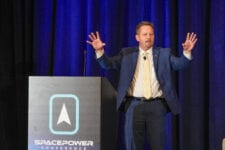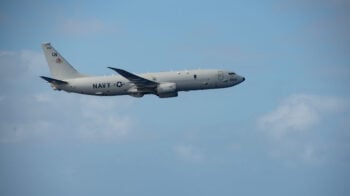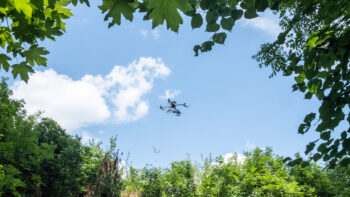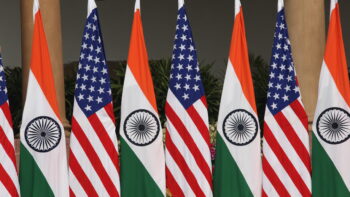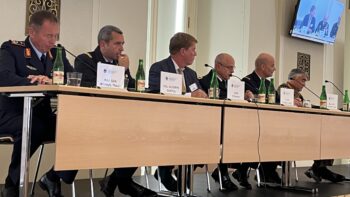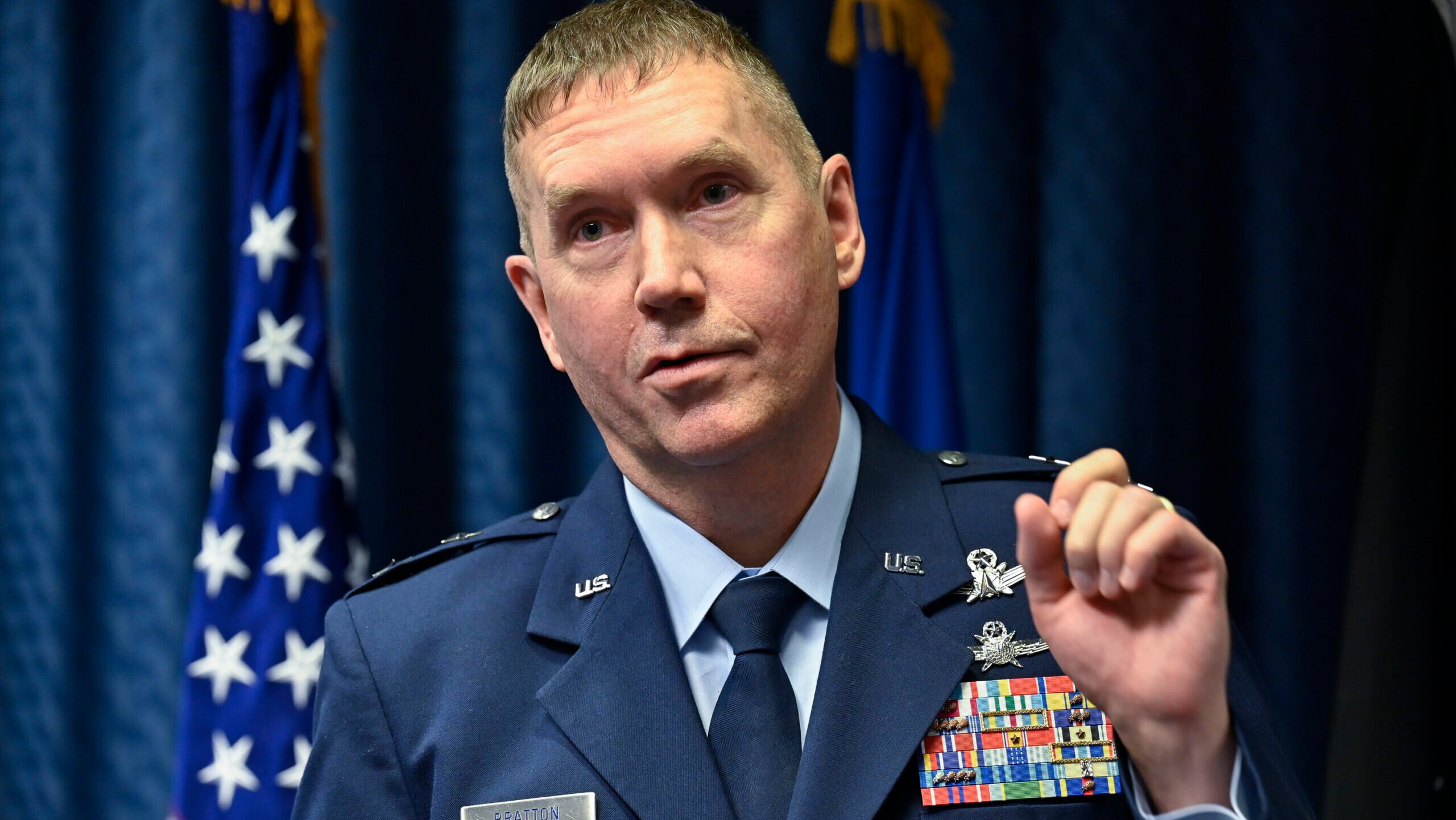
Maj. Gen. Shawn Bratton makes remarks during his promotion to major general at the Pentagon, Arlington, Va., March 16, 2022. Bratton is the commander of Space Training and Readiness Command. (U.S. Air Force photo by Eric Dietrich)
MCLEAN, VA — The new Space Force Futures Command will be created primarily by amalgamating existing resources, meaning that there shouldn’t be a need for “giant growth” in either manpower or funding, according to the service official in charge of its standup.
“We think most of Futures exists today,” Lt. Gen. Shawn Bratton, deputy chief of space operations, strategy, plans, programs and requirements, told the Potomac Officers Club 2024 Space Summit on Tuesday. Bratton was named to the deputy slot in December, pinning on his third star.
He explained that he has already “grabbed a couple of colonels” to create a “task force” to flesh out what the new command’s exact resource requirements will be.
“I wouldn’t say I have a handle on the resource requirements yet. I’m trying to get that initial cadre in place, which is just from existing resources, to answer that question. I’d love to have answers by tomorrow, but realistically, by the end of summer,” Bratton said.
The plan for a new Futures Command, echoing similar constructs in the other services, was announced by Chief of Space Operations Gen. Chance Saltzman on Feb. 13 — part of Air Force Secretary Frank Kendall’s overarching revamp designed to increase readiness for “great power competition” with China and Russia. (Kendall oversees both the Air Force and Space Force.)
It will be made up of three components: A Concepts and Technologies Center, a Wargaming Center and the Space Warfighting and Analysis Center (SWAC) that was stood up in 2021.
Bratton explained that centers would in sequence, starting with the Concepts and Technologies Center, screen early-stage science and tech for potential applicability to military space needs. Ideas that pass, he said, would then go to the Wargaming Center to be “fleshed out” via modeling and simulation, table-top games and exercises to assess their potential impact on “winning the war” as well as their practicality. The Wargaming Center, in turn, would make recommendations to the SWAC, which would determine realistic options for adopting new capabilities and integrating them into the Space Force’s force structure.
Bratton noted that SWAC already exists and has a staff and a budget. Similarly, he said, “we think a lot of the wargaming exists” — citing the long-standing Schriever Wargame as one example — just “not to the level that we want to do the things that I want.”
As for the Concepts and Technologies Center, Bratton said it is “really the new area,” but that his initial thoughts are perhaps it can be created by bringing a limited amount of “human brainpower” to the problems and relying on the current “doers” such as Air Force Research Laboratory, the Defense Advanced Research Projects Agency (DARPA) and the Defense Innovation Unit (DIU) to actually undertake assessments.
Cislunar And Dynamic Space Operations: Ripe For Futures Command Scrutiny
Bratton said that the focus for Futures Command will be on capabilities that might be available and relevant to space operations some 15 to 20 years into the future; that is “two FYDPS [five-year Future Year Defense Programs] out and beyond.”
He asserted that two areas that could be of first interest are cislunar space operations and the capabilities that US Space Command has dubbed “dynamic space operations (DSO).” DSO includes things like in-space refueling and other on-orbit activities that the Space Force refers to as “space access, mobility and logistics (SAML)” [PDF] — such as new propulsion techniques to allow spacecraft to maneuver faster and/or for longer periods of time.
Despite strong advocacy from US Space Command, especially the command’s just-retired deputy Gen. John Shaw, Bratton said DSO has yet to prove its “military utility.”
“I think we need our homework to be better in this area to prove the case. Is this the key to winning the war … or is sort of nice to have and will be helpful, but maybe is less important?” he said.
Neither is it clear from current threat assessments that cislunar operations are going to be needed, Bratton said, at least anytime soon. The question, he added, is “whether the adversary is there right now” in a way that requires new Space Force capabilities.
With regard to cislunar operations, as well as SAML, Bratton said: “I haven’t decided whether that’s a game-changing capability.”
“In the end,” he said, it “really comes down to what are we going to put into the budget.” And the job of Futures Command, he explained, is to be able to provide Kendall with “decision quality data” to be able to make those decisions and the necessary tradeoffs required.

